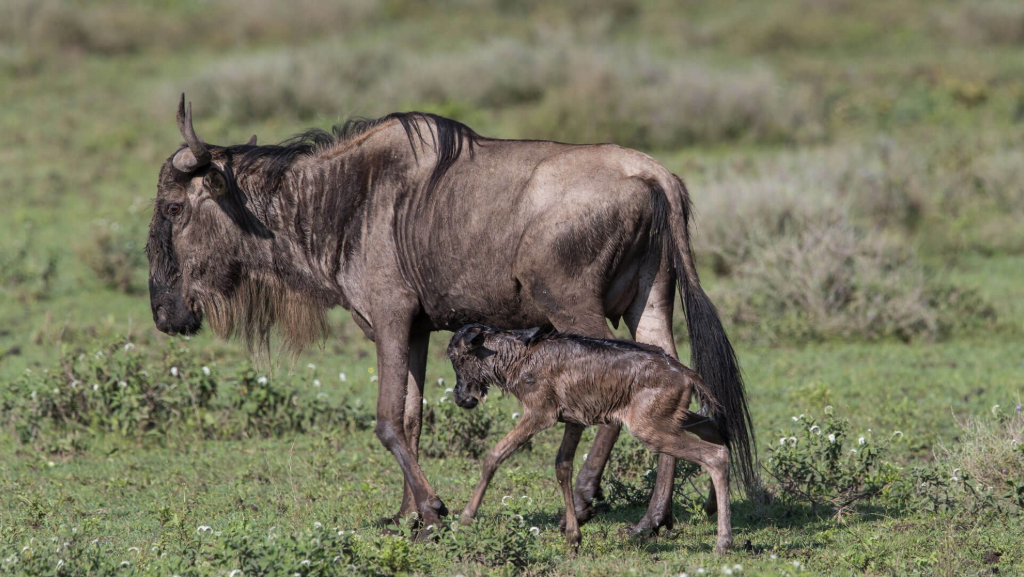
Ready for Tanzania’s most enchanting show? It’s the Serengeti Wildebeest Migration Calving Season – a baby marathon of sorts! This wild adventure is filled with – adorable newborn calves, thrilling predator-prey encounters, with one aspect underlining Tanzania Safari Vacations, i.e. the circle of life that makes us admire the majesty of nature!
The Timeline of the Calving Season

The Serengeti National Park Migration typically plays itself out in a cyclical pattern, with the timing of the calving season influenced by factors like:
- Rainfall Patterns, and
- The Avaialability of grazing grasses.
Once you understand the timeline of this season you will have a great time witnessing the majesty of nature on Serengeti National Park Tours. We have done a thorough breakdown of the timeline below for this purpose:
Late January to February – The Animal Migration in Serengeti National Park begins its journey from the southern Serengeti plains in Tanzania. It is where the wildebeest herds gather to graze on the lush grasses following the short rains.
March to April – As the herds continue their northward migration, they reach the central Serengeti and begin to gather in the Seronera region. This period marks the onset of the calving season, with thousands of pregnant wildebeest giving birth to their calves.
Late April to May – The calving peaks during this period, as the majority of wildebeest females give birth within a few weeks of each other. The vast Size of Serengeti National Park is dotted with newborn calves, attracting predators such as lions, cheetahs, and hyenas.
June to July – By late June, the wildebeest herds start to move further north towards the Grumeti River and the Western Corridor in the Serengeti National Park Migration Map. The calves, now stronger, join their mothers in the journey, navigating through crocodile-filled waters and grassy plains.
July to August – The Serengeti National Park Tanzania Famous Migration reaches its climax as the herds cross the Mara River into the Maasai Mara Reserve in Kenya.
September to October – After crossing the Mara River, the wildebeest herds spread out across the expansive grasslands of the Maasai Mara and the northern Serengeti. They continue to feed and replenish their energy reserves before the cycle begins again.
Understanding this timeline allows safari-goers to plan their Serengeti National Park Vacations accordingly – ensuring they are in the right place at the right time.
Table of Contents
ToggleWitnessing the Wildebeest Birthing Ritual
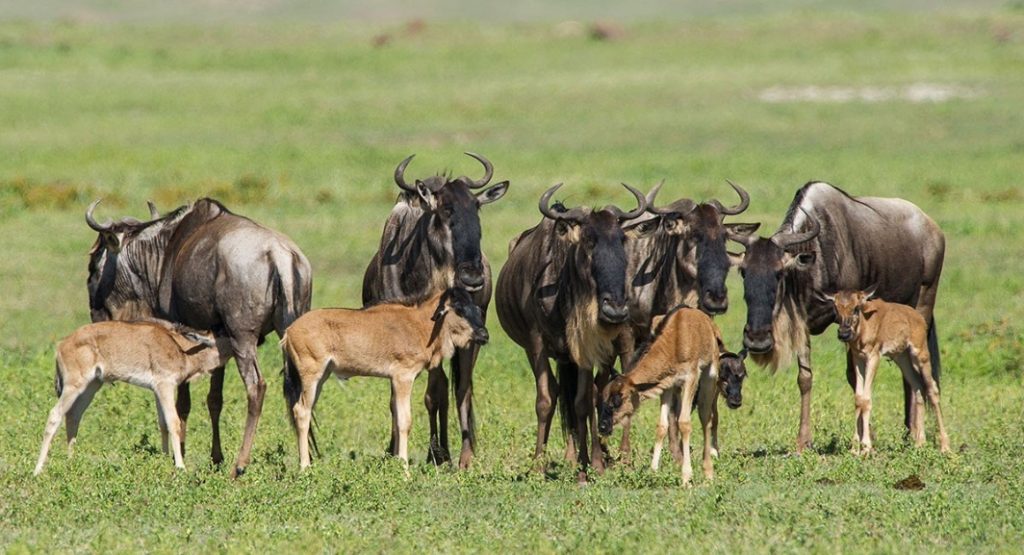
Next on the list of the Tanzania Wildebeest Migration is a closer look at what makes the calving season’s birthing ritual so captivating.
- Wildebeests (also known as gnus) are highly synchronized in their birthing process.
- The majority of wildebeest females give birth within a short period, typically a few weeks during the Serengeti Calving Season in Tanzania.
- Wildebeest mothers carefully select suitable birthing grounds, usually in open grasslands where visibility is high.
- This enables them to spot potential threats from a distance.
The Birthing Process
When a pregnant wildebeest is ready to give birth, she often isolates herself from the main herd to find a secluded spot.
The Time it Takes to Give Birth – Births typically occur during the daytime, and the process is relatively quick, lasting only around 15 minutes to an hour.
The mother wildebeest will find a suitable spot, often a patch of soft grass, and lie down to give birth. Calves are born hooves-first, and once fully emerged, they are immediately mobile and ready to stand within minutes.
Motherly Care and Affection
Wildebeest mothers are incredibly attentive to their newborn calves. Immediately after birth, the mother cleans the calf, removing the birth membranes and encouraging it to stand and nurse.
- Within minutes, the calf is on its feet.
- They are a bit wobbly at first but quickly gaining strength and coordination.
- The mother guides her calf to suckle, providing it with essential nutrients, rich in antibodies – to boost its immune system.
The Birthing Ritual of the Serengeti Calving Season is not only a celebration of life but also a reminder of the harsh realities of survival on the savannah. And, experiencing this ritual firsthand is a privilege reserved for the special few who take up the prospect of a Safari in Serengeti National Park.
Best Locations in the Serengeti to See the Calving Season
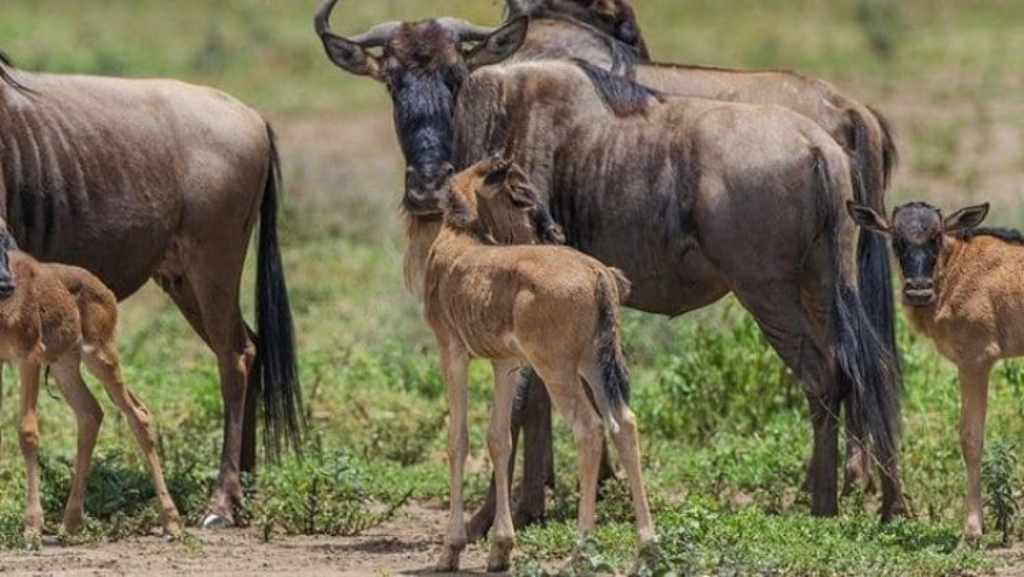
In the vast plains near Ndutu, the unique combination of nutrient-rich soil and lush grasses provides an irresistible haven for wildebeest mothers to give birth and nurture their newborn calves. Over a period of two to three weeks, the landscape is transformed into a nursery for over half a million wildebeest calves, with as many as 8,000 being born in a single day.
The characteristics of what makes the Ndutu region great for the Calving Season in Serengeti National Park is detailed out in the representation that follows:
| LOCATION | KEY FEATURES |
| Ndutu Plains | • Abundance of sweet grasses, nourished by volcanic ash from ancient eruptions. • Over half a million wildebeest calves born within two to three weeks. • Up to 8,000 wildebeest calves born in a single day. • Ideal terrain for photography, capturing tender moments between mothers and calves. • Presence of predators, including lions, cheetahs, and leopards, offering thrilling wildlife sightings. |
From tender moments between mothers and calves to thrilling predator-prey interactions, the Ndutu Calving Season is a spectacle of nature’s majesty.
On Safari – Exploring the Circle of Life in the Serengeti
The Serengeti National Park Calving Season symbolizes the cycle of life and renewal. As the herds gather round the southern Serengeti plains and the Ndutu region, wildebeests’ females give birth to their calves in mass.
- Witnessing the tender moments between mother and newborn calf is a reminder of the enduring bond between parent and offspring.
- Moreover, the Best Safari Tours Serengeti National Park also manage to showcase the predator-prey dynamics.
- Lions, cheetahs, hyenas, and other Serengeti National Park Animals are drawn to the abundance of vulnerable prey – creating moments of utter thrill for safari-goers.
Hence, it can be aptly stated that Tours in Serengeti National Park exemplify the exploration of all living things and the enduring beauty of nature’s circle of life.
Birth and Renewal of Tanzania’s Calving Season – 2024 Edition!
So, as we leave behind the world of Tanzania Wildebeest Migration, in particular the happenings of the calving season – one cannot help but marvel at the wonders of the natural world. For in the end, it’s not just about what we see, but how it makes us feel – alive, and connected with the majesty of nature.
Conservation Caravan Safaris encourages you to experience the magic of the Serengeti and witness the Wildebeest Migration calving season. Reserve your Tanzania Safari Vacations adventure with us today to make it happen!
Related Posts
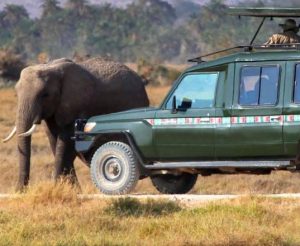
Are You Listening To Your Tanzania Safari Guide – Yes/No
In the mesmerizing realm of savannah’s wildlife, your Tanzania Safari Guide serves as your gateway to understanding and appreciation. But, are you truly tuned in to your safari guide's wisdom? …
Read More
What Type Of Safari Vehicles Will You Ride On Your Tanzania Wildlife Safari?
Tanzania Safaris are a world of adventure where the thrill of adventure meets the comfort of modern exploration. While traversing the wild landscapes one question that may come to mind – what kind o…
Read More
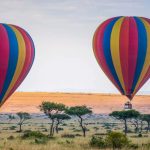


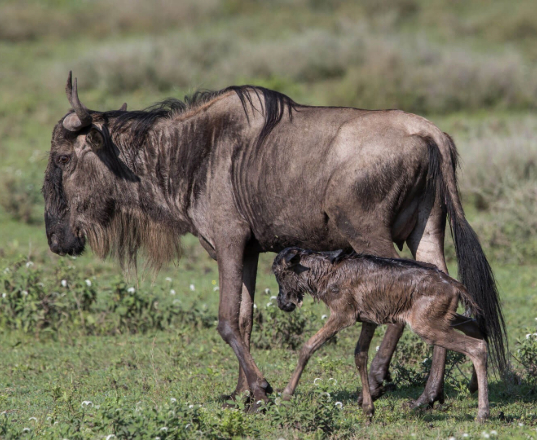

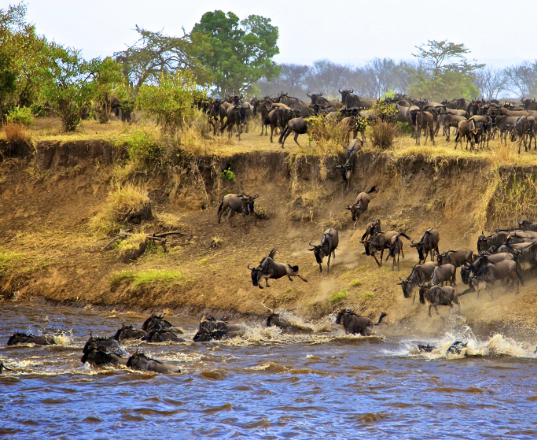



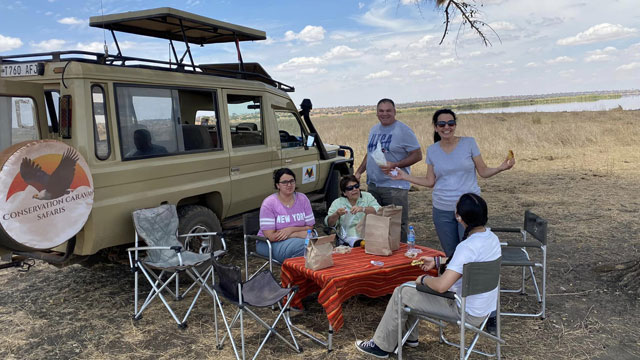
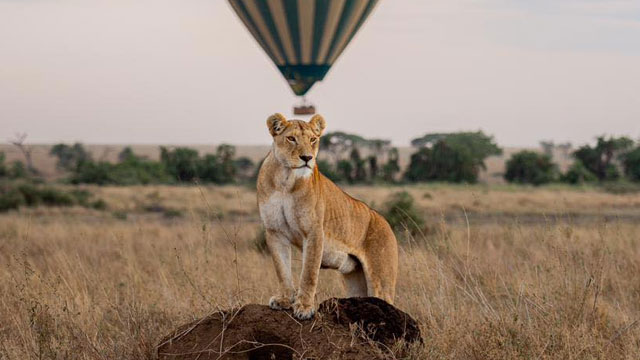







No Comments